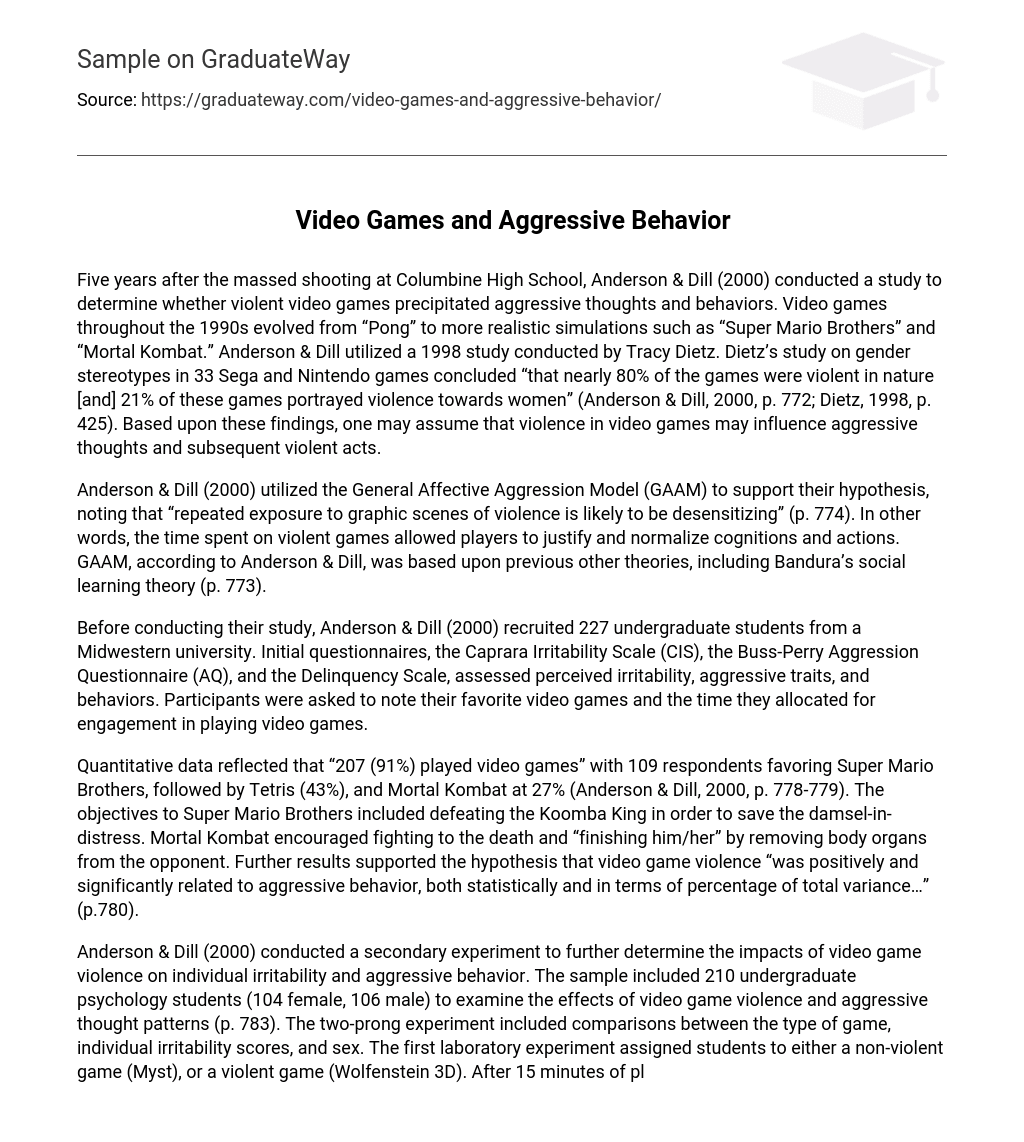Five years after the massed shooting at Columbine High School, Anderson & Dill (2000) conducted a study to determine whether violent video games precipitated aggressive thoughts and behaviors. Video games throughout the 1990s evolved from “Pong” to more realistic simulations such as “Super Mario Brothers” and “Mortal Kombat.” Anderson & Dill utilized a 1998 study conducted by Tracy Dietz. Dietz’s study on gender stereotypes in 33 Sega and Nintendo games concluded “that nearly 80% of the games were violent in nature [and] 21% of these games portrayed violence towards women” (Anderson & Dill, 2000, p. 772; Dietz, 1998, p. 425). Based upon these findings, one may assume that violence in video games may influence aggressive thoughts and subsequent violent acts.
Anderson & Dill (2000) utilized the General Affective Aggression Model (GAAM) to support their hypothesis, noting that “repeated exposure to graphic scenes of violence is likely to be desensitizing” (p. 774). In other words, the time spent on violent games allowed players to justify and normalize cognitions and actions. GAAM, according to Anderson & Dill, was based upon previous other theories, including Bandura’s social learning theory (p. 773).
Before conducting their study, Anderson & Dill (2000) recruited 227 undergraduate students from a Midwestern university. Initial questionnaires, the Caprara Irritability Scale (CIS), the Buss-Perry Aggression Questionnaire (AQ), and the Delinquency Scale, assessed perceived irritability, aggressive traits, and behaviors. Participants were asked to note their favorite video games and the time they allocated for engagement in playing video games.
Quantitative data reflected that “207 (91%) played video games” with 109 respondents favoring Super Mario Brothers, followed by Tetris (43%), and Mortal Kombat at 27% (Anderson & Dill, 2000, p. 778-779). The objectives to Super Mario Brothers included defeating the Koomba King in order to save the damsel-in-distress. Mortal Kombat encouraged fighting to the death and “finishing him/her” by removing body organs from the opponent. Further results supported the hypothesis that video game violence “was positively and significantly related to aggressive behavior, both statistically and in terms of percentage of total variance…” (p.780).
Anderson & Dill (2000) conducted a secondary experiment to further determine the impacts of video game violence on individual irritability and aggressive behavior. The sample included 210 undergraduate psychology students (104 female, 106 male) to examine the effects of video game violence and aggressive thought patterns (p. 783). The two-prong experiment included comparisons between the type of game, individual irritability scores, and sex. The first laboratory experiment assigned students to either a non-violent game (Myst), or a violent game (Wolfenstein 3D). After 15 minutes of play, participants were asked to assess their emotions and thoughts, which ranged from “friendly” to “anger.”
One week later, the participants were given a sensory time test on a computer. The goal was to press a button faster than the opponent. The probability to wins and losses were controlled, with the participant winning 13 times and losing 12 (p. 784). Each time the participant “lost” the victor emitted a 55-100 decibel noise blast.
Findings from these two controlled experiments concluded that those who played the violent video game, Wolfenstein 3D, “delivered longer noise blasts after lose trials than those who played the non-violent game” (p. 786). Further, data suggested that those who played the violent game experienced higher aggression and higher scores in Trait Irritability (TI).
Although evidence suggests a correlation among these three variables, one must note other factors which may lead to the propensity of aggressive traits and interpersonal violence. These factors include socio-economic status and family dynamics, neither of which were addressed in any segment of this study. Adverse childhood experiences (ACEs) also impact future relationships. Regardless, individuals learn social behaviors from other agents, including parents and peers.
References
- Anderson, C.A. & Dill, K.E. (2000). Video games and aggressive thoughts, feelings, and behavior in the laboratory and in life. Journal of Personality and Social Psychology, 78(4), 772-790. doi: 10.1037//0022-3514.78.4.772
- Dietz, T.L. (1998). An examination of violence and gender role portrayals in video games: Implications for gender socialization and aggressive behavior. Sex Roles, 38(5/6), 425-442.





